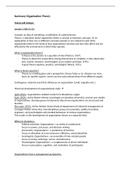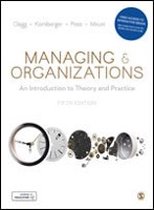Summary Organization Theory
Teams and Groups:
Lecture 1 (08-11-21)
Concept: an idea of something, or definition of a phenomenon
Theory: a statement about regularities within a concept or between concepts. Or an
explanation of how one or different concepts operate or are related to each other.
Organization theory: the study of how organizations function and how they affect and are
affected by the environment in which they operate.
What is organization theory?
- A theory is the answer to a question of why (Merton, 1967).
- Theory is about the connections among phenomena or variables, a story about why
acts, events, structure, and thoughts occur (Sutton and Staw, 1995).
- A good theory explains, predicts, and delights (Weick, 1955).
What is theory good for?
- Theory as a looking glass and a perspective: theory helps us to: sharpen our view,
focus on specific aspects, and to see the same phenomenon from different angels.
Contingency: external event that influences an organization (covid, migration etc.)
Historical development of organizational study
Until 1950’s: organizations studied mostly from disciplinary angles
Early 1950’s: led by Robert Merton (sociologist at Columbia University), several case studies
of organizations. Develop general statements about how organizations are structured and
function.
Also early 1950’s: led by Herbert Simon (head of department of industrial management at
Carnegie-Mellon University). Interdisciplinary group of economists, political scientists,
engineers, and psychologists who studied behaviour of various organizations.
This results in the development of organization theory as a separate field.
Different disciplines:
- Political scientists: Organizations = an entity of constituents
Focus on power, processes, and decision making
- Economists: Organizations = a production of function
Focus on allocation of scare resources, efficiency, and productivity
- Sociologists: Organizations = an ensemble of inter-related people
Focus on status, orderings, norms, and behaviour
- Psychologists: Organizations = a conglomerate of driven individuals
Focus on perception, cognition, and motivation of participants
Organizations from a management perspective:
, - Omnipresent Peter Drucker: ‘Young people today will have to learn organizations
the way their forefathers learned farming.’
- Highly diverse in their size, in their aims, in their structures, in their success, and in
the way we analyse them. However, they do have several characteristics in common.
What are organizations
- Two or more people (social dimension)
- Who (are supposed to), cooperate with each other?
- Within a formally established structure
- Mobilizing and using resources
- Achieving a certain goal
To understand organizations, we need to analyse
Why do organizations exist
,Organizations as a value chain
How organizations create value
- Organization’s inputs: organizations obtain inputs from its environment
Raw materials
Money and capital
Human resources
Information and knowledge
Customers of service organizations
- Organization’s conversion process: organizations transform inputs and adds value to
them
Machinery
Computers
Human skills and abilities
- Organization’s outputs: organizations release output to their environment
Finished goods
Services
Dividends
Salaries
Value for stakeholders
- Organization’s environment: sales of outputs allow organizations to obtain new
supplies of inputs
Customers
Shareholders
Suppliers
Distributors
Government
Competitors
All these four steps are related to each other, they form a circle.
, How managers measure organizational effectiveness
Source: Jones (2013): p. 38; Table 1.1
Management and organizations:
We can differentiate between managing as a practice, and as something what we do. We can
define organizations as social systems that emerge from social practice.
- Organizations are goal-oriented collectives in which formal members are organized
Being organized means being an element in a systematic arrangement of parts
which together are meant to create a unified, organic whole.
Formal membership means that an explicit and legitimate decision for or against
membership can be taken by a pre-specified position within the organizational
hierarchy. Membership implies specific rights and duties within an organization.
- Managing as a practice encompasses all actions taken by organizational members
that are meant to fulfil one or more of the following functions for the organization:
planning, organizing, staffing, directing, and controlling.
Delegation is the key to analyse organizations.
Tasks need to be divided between individuals participating in the organization
- Hierarchy
- Delegation of tasks
Delegation is intentional but outcome of delegation is often unintended
Principal-agent problems the people to whom a task has been delegated (agents) do not
do what they are supposed to do by their superiors (principals).
Causes:
- Agents pursue their own interests
- Often it is not possible for the principals to define all aspects of the task delegated





